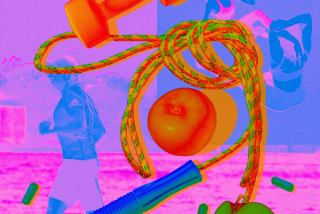Bored With Carrots? Try a <i> Camu Camu </i> : Nutrition: A growing variety of produce is now available to Americans. The wider selection might be just the motivation for us to eat smarter.
- Share via
Last November, the U.S. Department of Agriculture, like a great national mother-figure, told us all to eat our fruits and vegetables. For the first time the organization’s guidelines specified how much to eat, and it was a lot: three to five servings of veggies and two to four of fruit every day.
If your palate is unacquainted with anything more exotic than apples and oranges, that could be a sure prescription for boredom. Fortunately, there’s no need to stick to the ordinary for nutrition’s sake. If you’ve had it with honeydew, you can try a horned melon instead. Bored with the usual broccoli and baked potatoes? Stir-fry some chayote and pop a Jerusalem artichoke into the microwave.
A growing variety of produce is now available to Americans, even in the winter months, and we’re learning to appreciate foods other cultures have relished for centuries.
“I don’t think we need new foods that are higher in fiber or vitamins in order to meet the USDA guidelines,” says Barbara Schneeman, head of the nutrition department at UC Davis and a member of the guidelines committee. “A better strategy is to broaden our range of foods--to tap into a worldwide food market.”
Some of these new taste experiences could be just around the corner. Every few months, botanist Hans Beck of the New York Botanical Garden takes his students on a trip to the Latino and Asian markets of New York City’s Lower East Side. Inside the crowded stores, they find themselves in a strange, new world of plants: Boxes of gnarled, furry tubers line the walls, flanked by unusual squashes, odd cabbages and turnips, green guava fruits and packets of tamarind paste.
One large crate holds what looks like tough, overgrown bananas--actually yellow and green plantains. Beck picks up a plantain and examines it.
“This is a wonderful source of potassium, niacin and all kinds of other goodies,” he says. “Health-conscious people would love this fruit.”
Plantains are just one of the world’s many little-known fruits and vegetables that have excellent nutritional properties. The camu camu of Peru, for example, has as much as 30 times the vitamin C of citrus fruit. And the protein-rich kiwicha, a tropical amaranth, is so high in amino acids that it’s nutritionally comparable to milk.
These two foods haven’t made it to American shops yet, though other types of amaranth, with similar nutritional properties, can be found in health-food stores. Many other imported produce items can be ordered by phone or mail.
One problem with marketing unusual foods is that consumers need guidance. Beck has found that many kinds of food are quickly accepted once consumers are taught what to do with them. For instance, Beck likes to introduce his classes to a tuber called jicama. Eaten fresh, it’s crunchy and sweet. It’s also delicious when made into cole slaw or peeled and cooked.
“My students went nuts over it once they knew what it was,” he says.
“It’s a long process,” agrees Karen Caplan, president of Frieda’s Finest of Los Angeles, a wholesaler that sells special fruits and vegetables to supermarkets nationwide. “The first time I saw a purple potato, I covered my eyes to eat it,” she says. What she experienced was a rich potato taste and texture. Purple potatoes became part of Frieda’s line.
Despite obstacles, Americans are becoming more cosmopolitan in their appetites. Some supermarkets now carry as many as 400 produce items during the year, according to Noel Vietmeyer, a rare-plants expert at the National Academy of Sciences.
“It’s because our country is getting so many people from the Caribbean, South America, Korea, Japan and Southeast Asia who bring their native foods with them,” he says.
Even Beck is sometimes surprised at the diversity in ethnic markets. On the day we went shopping, he spotted some small mesh bags filled with round, marble-sized fruits.
“There’s one I’ve never seen before,” he said, as he snapped up a bag.
More to Read
Eat your way across L.A.
Get our weekly Tasting Notes newsletter for reviews, news and more.
You may occasionally receive promotional content from the Los Angeles Times.










